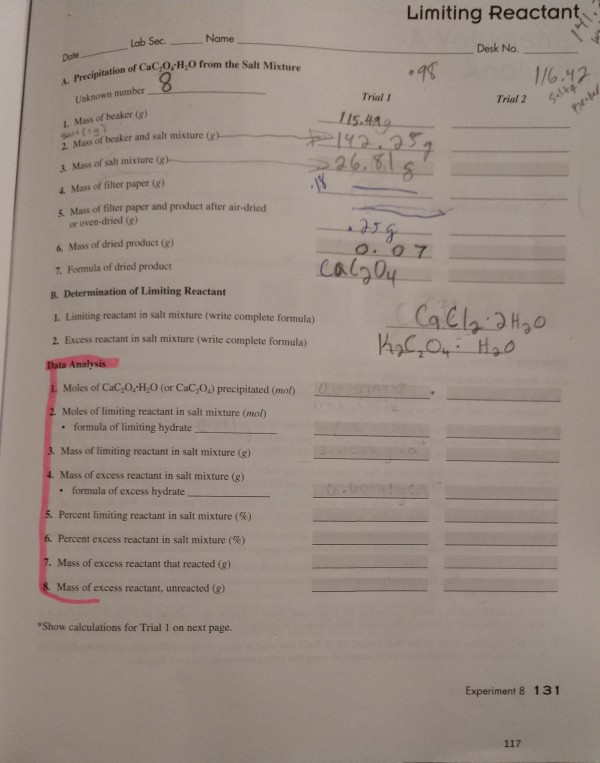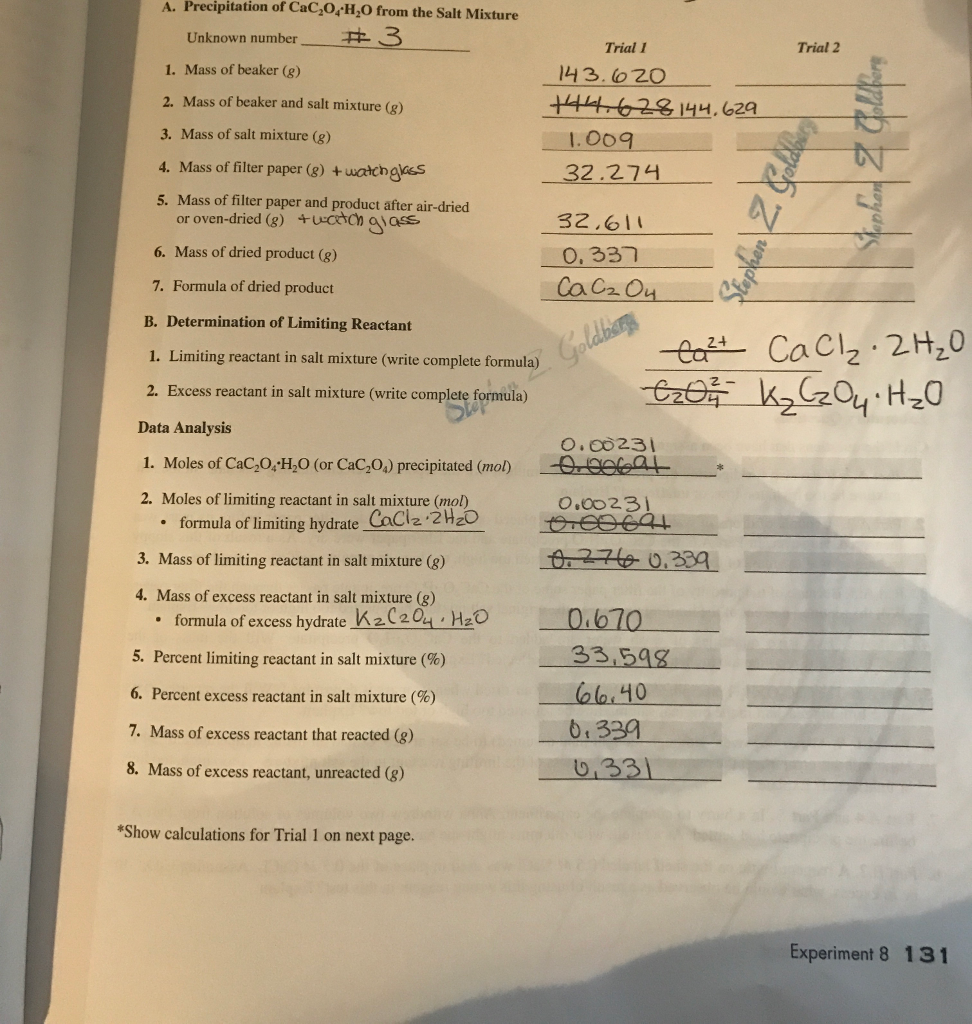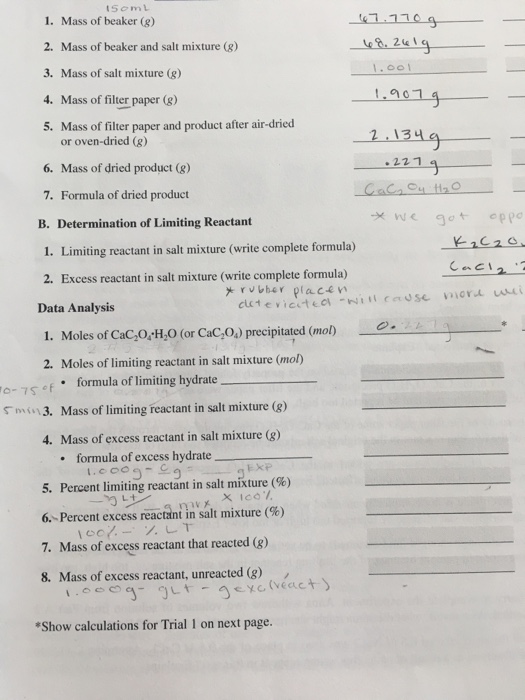2HClaq Zns ZnCl 2 aq H 2 g. The reactant with the smallest mole ratio is limiting.

Solved Limiting Reactant Lab Sec Name Ion Of Cac Och O From Chegg Com
Subtract this from a grams to get the mass of the excess reactant.

. Include formula of excess hydrate. Mass of salt mixture Mass of limiting reactant in salt mixture 1137g 0106 g 1031 g 5. A Sandwich-Making Analogy This video from Noel Pauller uses the analogy of making sandwiches.
Excess reactant in salt mixture write complete formula K2C2O4H2O Data Analysis. Convert mass into moles for both reactants. Moles of CaC2O4H2O or CaC2O4 precipitated mol 0 0.
1223 g Mass of filter paper and CaC2O4H2O. Percent excess reactant in salt mixture 1031 g 1137 g x 100 9068 7. The difference between the total mass of the original salt sample and the mass of the BaCl22H2O 0942 g 0229 g 0713 g.
04 05 and as expected O 2. Percent limiting reactant in salt mixture Show calculation. Mass of limiting reactant.
Limiting reactant in salt mixture write complete formula CaCl2 2H2O. In this video well determine the limiting reactant for a given reaction and use this information to calculate the. Divide the actual number of moles of each reactant by its stoichiometric coefficient in the balanced chemical equation.
Write the moles on top of each reactant and divide them by the corresponding coefficient. 823molactual 2molstoich 412. Find mass of limiting reactant.
Percent excess reactant in salt mixture _____ 4. Moles of excess reactant that reacted. If you start with 100.
Equals mass of salt mixture minus mass of limiting reactant. Since the reaction uses up hydrogen twice as fast as oxygen the limiting reactant would be hydrogen. Line 4 A3 Line 3 Divide calculated masses by original sample mass to obtain mass s.
Once you have identified the limiting reactant you calculate how much of the other reactant it must have reacted with and subtract from the original amount. Include formula of excess hydrate. In a chemical reaction the reactant that is consumed first and limits how much product can be formed is called the limiting reactant or limiting reagent.
Use the atomic masses of Ag and S to determine the number of moles of each present. Percent of limiting reactant in mixture. G of each reactant how much calcium carbide would be produced.
Line 3 Line 2 Mm Subtract mass of limiting reactant from original sample mass salt mixture to find total mass of other excess reactant. Salt Mixture 264g Mass of filter paper. Calculating the mass of a substance in a mixture.
Percent limiting reactant in salt mixture 0106 g 1137 g x 100 932 6. Then use the balanced equation to calculate the number of moles of sulfur that would be needed to react with the number of moles of silver present. Include formula of limiting hydrate.
For example if elemental analysis tells us that a potassium supplement contains 22 K by mass and we know that the K is present as KCl we can calculate the grams of KCl in the supplement. Iii The percent BaCl22H2O in the salt mixture is 0229 g0942 g x 100 243 BaCl22H20. The general problem Given the chemical equation and the masses of reactants determine the.
Formula of limiting hydrate eac4 Mass of limiting reactant in salt. Mass of original salt mixture. 4NH 3 5O 2 4NO 6H 2 O.
If the limiting reactant was found to be K2C2O4H2O how many grams of the limiting reactant are in the salt mixture. So find moles of K2C2O4H2O that react with also z moles Find its molar mass and then the mass of this quantity of K2C2O4 that reacts. For Trials 2 and 3 the percent CaCl2 2H2O in the mixture was 397 and 284 respectively.
Elemental analysis can be used to determine the amounts of substances in a mixture. Mass of excess reactant that reacted. 2Al 6HCl 2AlCl3 3H2.
Then use the actual yield to calculate the percentage yield. Calculate the mass of the limiting reactant BaCl2 in a salt mixture of mass 108 g knowing that the mass of the precipitate was 0231 g Ba3PO42 602 gmol Na3PO412H2O 380 gmol BaCl22H20 244gmol. The chemical equation for these reactions is given below.
MolesofAl frac mass g M_r frac 27 27 01 molesofHCl frac mass g M_r frac. To answer this question calculate first the theoretical yield of N 2CH 4O that should be made. 511 g of NH 3 X 1 mol of NH Solution 3 170 g of NH 3 X 1 mol of N 2CH 4O 2 mol of NH 3 X 903 grams of N 2CH 4O is the theoretical yield 601 g of N 2CH 4O yield Actual yield Theoretical yield X 100 312 g.
Whichever produces the SMALLEST amouht of product is the limiting reactant and the smallest anount of product is the actual amount of product produced. 100g of hydrochloric acid is added to 100g of zinc. 5272molactual 1molstoich 5272Mg.
Iii The percent Na3PO412H2O in the salt mixture is 0713 g0942 g x 100 757 Na3PO412H2O. Include formula of excess hydrate. Mass of unreacted excess reactant.
Find the volume of hydrogen gas evolved under standard laboratory conditions. Compare this result to the actual number of moles of sulfur present. Moles of limiting reactant in salt mixture mol 0 0.
12 Limiting reactant in salt mixture write complete formula Excess reactant in salt mixture write complete formula Analysis Moles of CCOrHO orCC04 precipitated mol 00024 naal- 00021 Moles of CaCo HO or CaC0 precipitated mol Moles of limiting reactant in salt mixture mol. Causey shows you how to find the limiting reactant reagent and the maximum product from a chemical equation using stoichiometry. Determination of Limiting Reactant.
Percentage of each salt mass of one hydrated salt0879g x 100. - To find the limiting reactant calculate how much product would be produced from ALL given reactants. Determine the limiting reactant when 2 mol of NH 3 and 2 mol of O 2 are reacted as follows.
1997 g Mass of air-dried CaC2O4H2O. Line 5 Line 3 A3 100 and Line 6 Line 4 A3 100. Formula of dried product CaCl2O4 H2O B.

Solved Te그 그그09 1 Mass Of Beaker G 2 Mass Of Beaker And Chegg Com

Solved A Precipitation Of Cac204h2o From The Salt Mixture Chegg Com

Solved 12 Limiting Reactant In Salt Mixture Write Complete Chegg Com
0 Comments